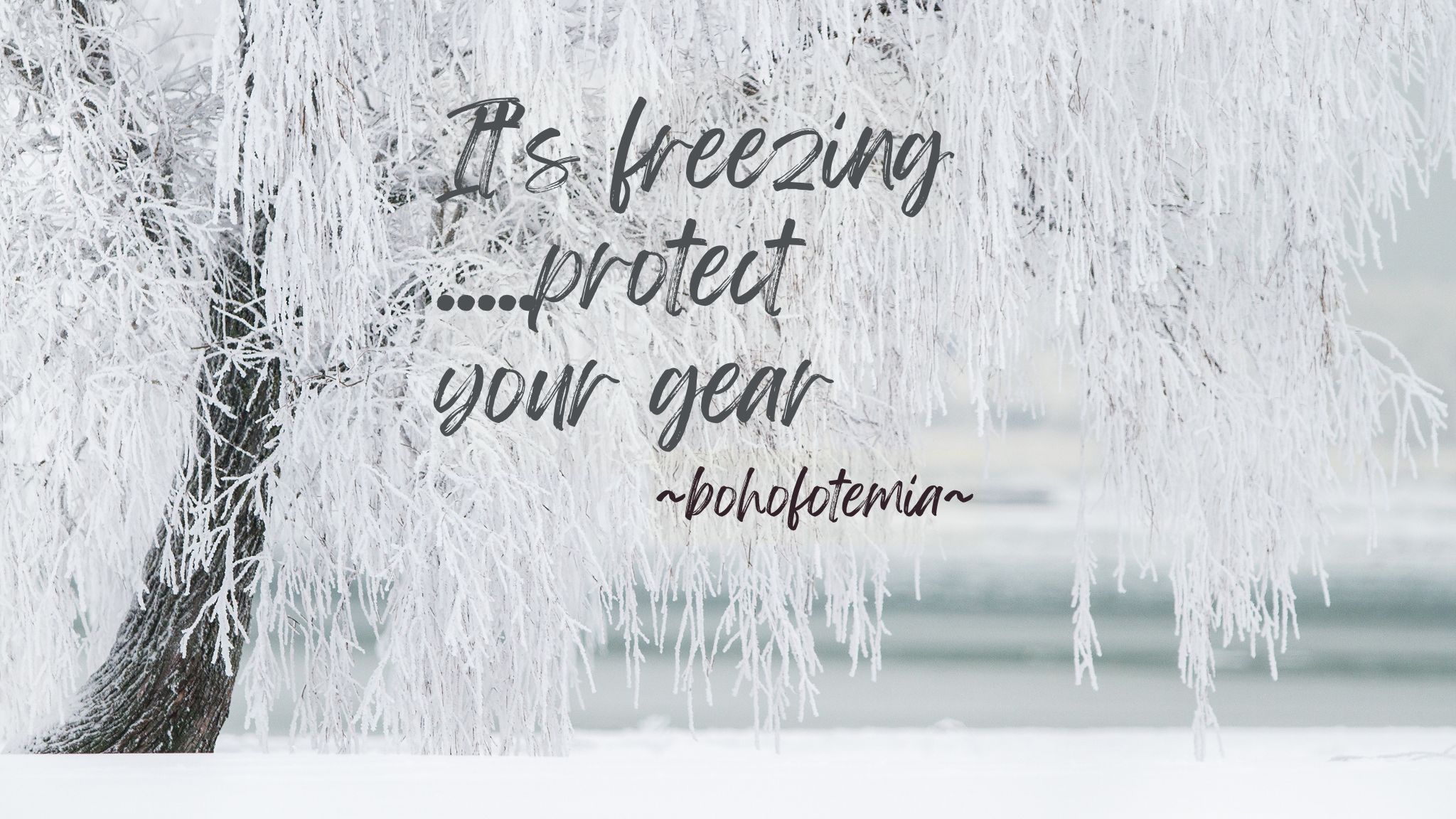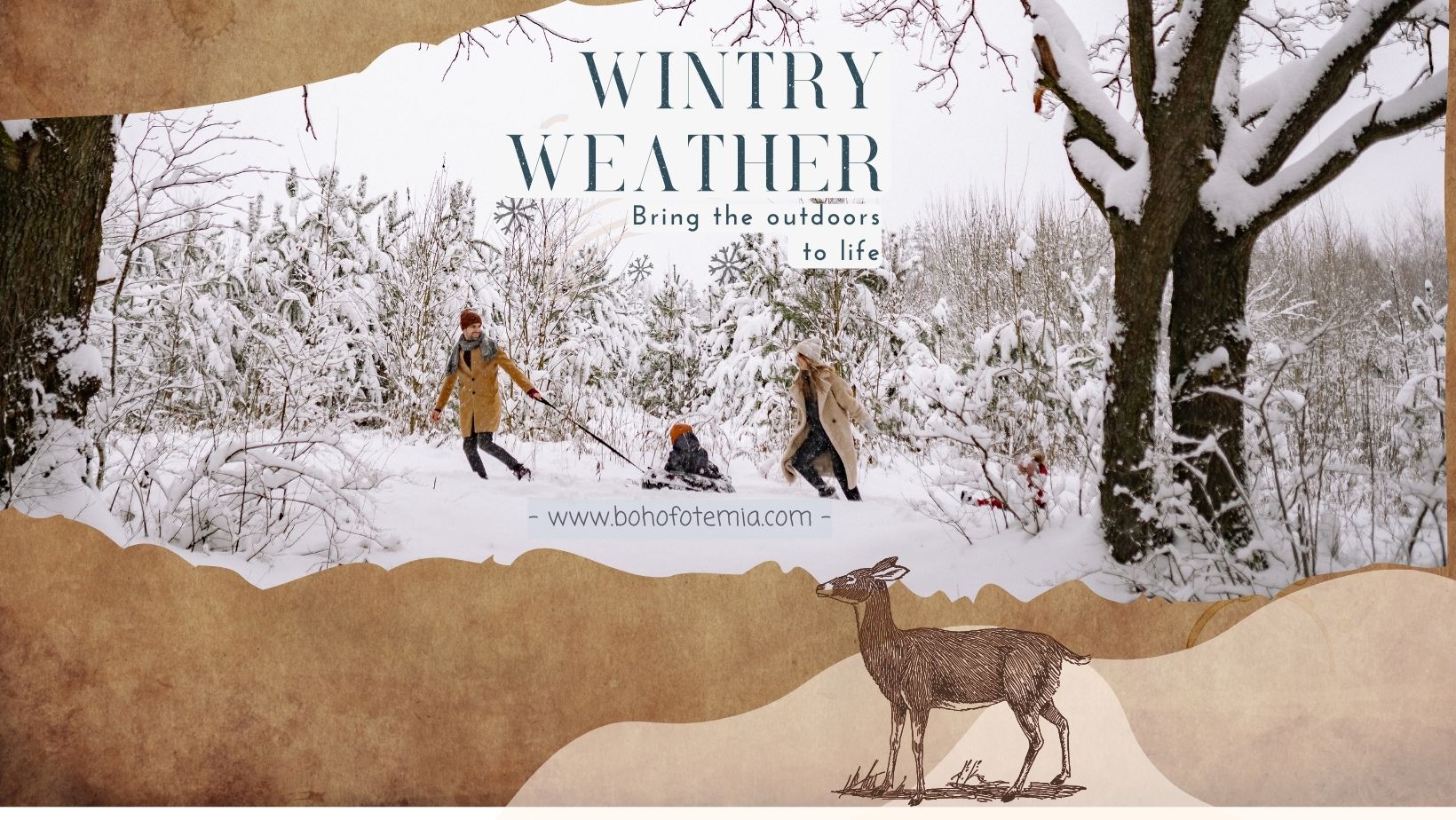You can grouse about the cold temperatures – or, with a bit of planning you can pack up your camera gear to create masterful photography even when it’s freezing outside.
Sometimes frigid temperatures makes us irritable. But, it always makes electronics irritable.
Outdoor photography brings a whole host of dilemmas. Sun rays can filter through trees leaving a smattering of white and gray blotches on your subject. Also, a direct aim at the sun can assassinate a camera sensor. And worse, freezing temps like the ones we have had this winter can screw with the sensitive electronics of digital cameras.
With the perils of outdoor photography, bohemian photographers really only have a few options. The easiest option tends to be the most common – complain about the weather and keep your camera in its case and your tush on the sofa. Or you can take a few hot minutes to do your research and then make a plan to capture great and wall worthy images.
Baby It’s Cold Outside
As autumn approached at the end of the year, the polar regions began to receive less sunlight, temperatures began to drop, and seasonal cooling began at the north pole. But, as polar temperatures dropped, the temperatures further to the south generally remain relatively warm as those areas continued to receive light and energy from the sun. Not this year. Almost everyone in the northern hemisphere gained an appreciation for our northern neighbors.
When the Winter Solstice approached on December 21st, photographers dreamed of taking photos of anything other than families around the Christmas trees, Kwanzaa gatherings and the delicious meals of Hanukkah. As wonderful as those events are, bohemian-spirited photographers long for mountaintops, forests, and snowy cabins.
Whether you are in a mild temperate climate or in the extremes, opportunity awaits for photographers. We only need to take a few moments to prepare our equipment and plan for any travel necessary.
One thing I can’t stress enough, during outdoor shoots in any kind of weather you have to be in charge of both planning and execution of your photo shoot. Other than that occasional lucky strike that all of us have had, and probably inspired us to pursue the craft further, great photography comes from planning ahead. If the destination is too cold, digital cameras can refuse to cooperate with adjustments, focusing, and even the aperture.
Protect Your Gear
Even cameras built for rugged conditions will benefit from some TLC during extreme temperatures. There are covers designed just to protect cameras from cold, rain, and snow, but you can make your own with a few things you most likely already have in your cabinets.

By adding a shower cap or a Ziploc bag, rubber bands and a lens hood, the harsh elements are one step away from affecting your gear. It goes without saying, changing lenses, opening battery compartments and anything with hinges on the camera should be avoided at near-freezing or below temperatures.
Electronics aren’t the only thing that can suffer. Batteries lose their power more quickly at low temperatures. While primary, non-rechargeable batteries tend to perform the best, all batteries will have a lower performance in extreme cold temps, while performing even in below freezing temperatures.
By keeping a pair of hand warming pockets to your camera bag, batteries can sometimes be restored. You can also keep your batteries warm by wrapping a small hand warmer around the section of the camera that contains the batteries.
Hand warmers that contain iron powder, sometimes mixed in with charcoal and salt, release heat when the packet is opened and exposed to air. The heat can last anywhere from a few hours to all day. It may not feel as if it’s doing much, but even a few degrees can help negate the cold.
The goal is to keep your camera cold but your battery warm. Since digital cameras tend to warm up on their own while turned on, you don’t want to heat the camera by wearing it next to your body under a heavy coat or by warming it up in the car.
Beware Transitions Indoors
Lastly, if your camera survived the cold, outdoor elements – the worst is not over.
Should you bring an ice-cold camera and lens into a room with warm, moist air, moisture will then condense out of the indoor air and onto the cold surfaces of the camera. The warm moisture condenses inside the cameras internal parts and lenses.
The moisture should evaporate if the equipment is allowed to warm up to room temperature. Should condensation form on the camera, remove the batteries until the camera has dried completely out. This will ensure that the camera is completely off and electronics are safe from further damage.
A much better procedure is preventing the moisture from condensing in the first place by sealing your camera gear in an airtight plastic bag before you bring it inside. This way the camera will be surrounded by the very dry air from outdoors. Put the camera and lens in the bag before you go indoors. Once indoors, it may be too late to keep condensation from forming on your gear.

My favorite editing software and digital product is Corel PaintshopPro and CorelDraw.Take advantage of discounts using this link:
BLACK FRIDAY SPECIAL PAINTSHOP PRO FULL VERSION $39.99
Click Here to download your free trial version.
Follow the Leader
It’s incredibly important to keep up with weather patterns, temperature changes, and the impact they have on not only your gear, but your subjects. Photographers who are people-pleasers will often find that their work can suffer when they cave to the customer to decide where or how to photograph a subject. As you become more experienced, you will better know your camera’s limitations as well as your own.
When your name and reputation, time and energy, are spent preparing, photographing, and editing family portraits or sports photos, only the photographer chooses where and when the shots are to be taken. This almost guarantees a huffy mama. Unfortunately, you do have to learn to effectively take charge in these scenarios – or don’t deal with this type of photography.
Don’t follow the leader. Be a leader who takes care of both your gear and your customers.
Q&A
Q: Can a neoprene cover work to keep equipment safe from cold temperatures?
A: Neoprene may prevent water damage, but it is possible that it could cause a digital camera to overheat. Some neoprene covers are designed to prevent dings and scratches, but not for use during operation.
Q: Can I just use a camera bag to keep the elements from stressing my equipment after photographing the snow?
A: While something is better than nothing, even better would be to place the camera inside a plastic bag prior to placing it in the camera bag. Then the camera can warm up slowly indoors with minimal condensation.
Q: Can I have a photo shoot with a family with small children in 20 degree temperatures?
A: Aside from the camera and equipment issues, small children shouldn’t be posing for a camera at 20 degrees Fahrenheit. A better idea is to pose the family in an ideal location when the temps are 40′ or above with some snow – applying a previous (or later) taken photograph of that same location when the scenery is perfect. Using layers in Paintshop Pro, or your favorite editing software, you can create the scene you want while taking photos of families in a more temperate setting.



very good